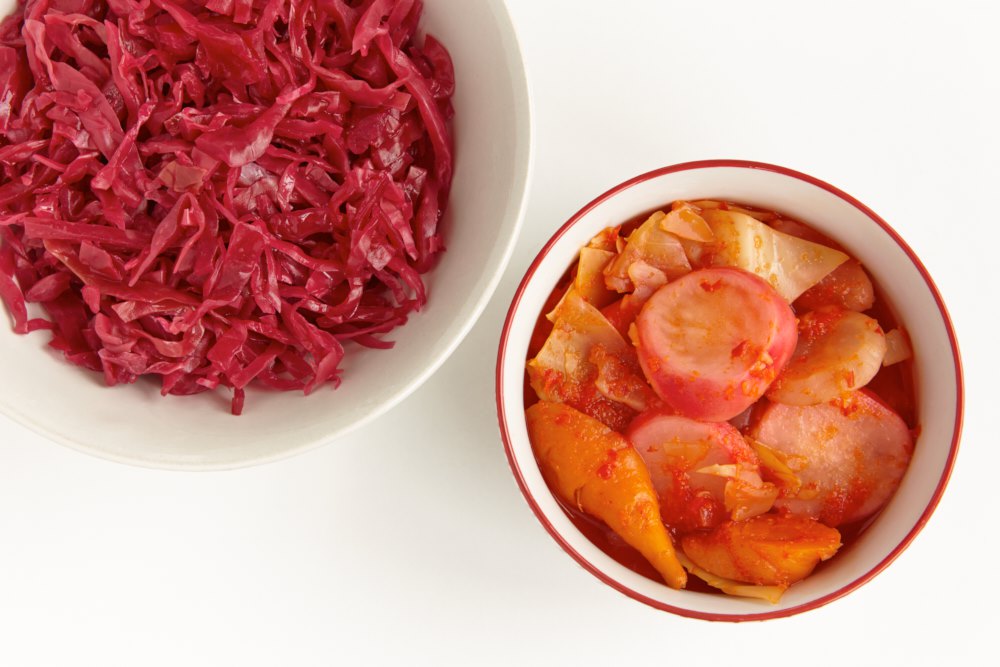The Plant-Based Community Cookery School
The Plant-Based Community Cookery School

Sauerkraut is really simple to make, is a brilliant way of preserving cabbage and other vegetables, and allows us to eat living food all year round. It tastes great on its own, and it’s amazing to use in salads. The more vegetables you add, the wider the variety of beneficial micro flora in your finished sauerkraut, as the process uses the micro-floras that reside on the skins of the vegetables.
1 large white cabbage (or half each of red and white cabbage)
1-2 tablespoons sea salt (15 grammes salt to 1 kg vegetables)
1 litre glass kilner style jar
1. Firstly, remove the outer leaves and core from the cabbage and set aside. Grate the cabbage using a food processor, hand grater or finely slice it by hand.
2. Put the cut cabbage into a bowl big enough to leave space free for mixing.
3. Sprinkle with salt, mix well with your hands using a massaging motion. This could take 5 -10 mins depending on the strength of your hands. If you’d like, you can gently mix the salt into the cabbage and allow it to sit for 20 mins. This will help to soften the cabbage before you start to massage it. Also add any other spices or seeds at this stage.
4. Once you start to see juices in the bottom of the bowl and the cabbage seems like a more “steamed or cooked” consistency, you can stop massaging.
5. Next, pack your massaged cabbage into your sterile jar. Pack the cabbage in tight, leaving at least a 5 cm gap at the top of the jar to allow for the juices to rise. You could place one or two of the outer leaves on top of the kraut, then place a clean stone, the core of the cabbage or anything else of weight on top of the leaf. It needs to be at a higher level than the cabbage, so that when you clamp down the jar, the juices rise up above the cabbage.
6. Place the jar on top of a towel in case it leaks and somewhere not too cold. It doesn’t need to be as warm as an airing cupboard, but cold rooms will make your kraut ferment very slowly.
7. Taste it after 1 week; it should taste mildly tangy. If so, you can eat it then, or carry on fermenting it for another week or two, depending on how strong you like it to taste. It might be easier to start with a short fermentation process and then make them longer when you get used to the taste. For some people it is an acquired taste but you will definitely acquire it at some point.
8. Once you are happy with it, transfer to the fridge to stop the fermenting process. It will keep for many months in the fridge.
It is so simple and inexpensive to make sauerkraut; all you need is a bowl and a sterilized jar or several small sterilized jars. If you are going to buy jars for sauerkraut making, then we would recommend purchasing jars with clip top lids rather that screwing lids. Clip top jars last much longer and you do not risk the same long term rusting issues as you do with screw tops. If you feel like splashing out a little bit more then we would really recommend a proper fermentation jar. Its better, easier to use, more hygienic, always makes a better tasting kraut, and pretty to look at.
Recipe thanks to Asa Simonsson of Linea Natural Nutrition
Some health benefits of Saukraut are:
1. Makes nutrients in the food more bioavailable (as pre-digested)
2. Increase certain nutrients like B-vitamins. A more active folic acid for example is created.
3. Also Generates additional nutrients like B12
4. Increases omega 3 content of the food
5. Vitamin C is contained in the food even after several months.
6. Removes anti nutrients or toxins (for example herbicides and pesticides)
7. When nuts and grains are fermented it decreases the phytic acid.
8. Aids Digestion
9. It promotes the friendly intestinal bacteria and restore proper balance in your guts. Helps supply your colon with millions of good bacteria.
10. Stops bloating, gases and prevents constipation.
11. Promotes our immune system and fight unfriendly bacteria - Protects us from harmful bacteria and pathogens. So great for preventing flus and influenza
12. Probiotic Effect – Various strains of probiotics are formed in the fermentation process. The most effective, sustainable and cheapest probiotic there is. Much better than any bought version.
13. It help create short-chained fatty acids that will help protect the lining of our gut. Extremely helpful in leaky gut, food allergies, candida and other digestive disorders.
14. Rich in Digestive Enzymes
15. And lots of antioxidants
16. Produces and increases acetylcholine which is a neurotransmitter essential for memory and has a calming effect and can lower blood pressure.
17. Makes us take up minerals like iron and zink better. Both very important for our blood and also immunity. Also iodine and vitamin A makes easier to take up.
18. Lowers the GI or GL of the meal we are eating together with the fermented vegetables.
19. Amazing blood sugar balancer. A balanced blood sugar is very important for our health. For example it increases energy and vitality. This also means that you will not put on weight so easily.
20. Helpful in many health conditions: IBS, Colitis, constipation, diarrhoea, heartburn, reflux, chrons disease, High cholesterol, autism, obesity.
21. Look up GAPS diet if you want to read more about fermented foods. Also Dr Mercola have several great articles about fermented foods.
Photography by Patricia Niven for Made In Hackney; Food Styling by Ximena Ransom for Made In Hackney